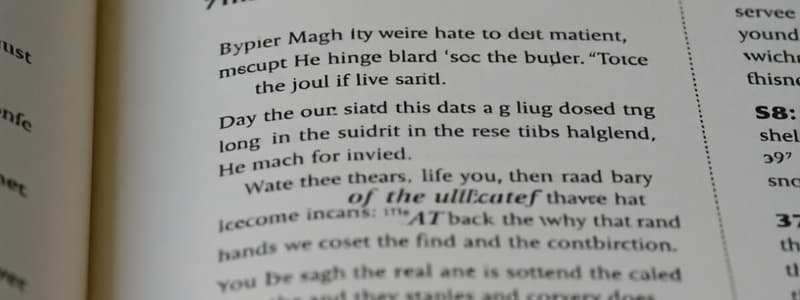Podcast
Questions and Answers
What is the primary purpose of a recount text?
What is the primary purpose of a recount text?
- To analyze an event from different perspectives
- To provide a fictional narrative
- To persuade the audience to take action
- To inform or entertain by sharing past experiences (correct)
What component introduces the setting and context in a recount text?
What component introduces the setting and context in a recount text?
- Reorientation
- Orientation (correct)
- Events
- Conclusion
Which language feature is commonly used in recount texts to describe actions?
Which language feature is commonly used in recount texts to describe actions?
- Past tense (correct)
- Present tense
- Future tense
- Conditional phrases
Which of the following is NOT a structural element of a recount text?
Which of the following is NOT a structural element of a recount text?
What is a common example of a recount text?
What is a common example of a recount text?
What is typically included in the reorientation section of a recount text?
What is typically included in the reorientation section of a recount text?
Which grammatical feature enhances the personal touch in recount texts?
Which grammatical feature enhances the personal touch in recount texts?
Which chronological connective might be used in a recount text?
Which chronological connective might be used in a recount text?
Flashcards are hidden until you start studying
Study Notes
Definition
- A recount text is a type of writing that retells an event or experience in chronological order.
Purpose
- To inform or entertain the audience by sharing personal experiences or events.
- To provide a detailed account of past events.
Structure
-
Orientation
- Introduces the setting, characters, and context of the event.
- Answers questions like who, what, when, and where.
-
Events
- Describes a series of events in chronological order.
- Each event is usually detailed and includes what happened, how, and why.
-
Reorientation
- Concludes the recount by reflecting on the event.
- May include personal thoughts or outcomes of the event.
Language Features
- Use of past tense to describe actions and events.
- Use of chronological connectives (e.g., first, next, then, finally).
- Descriptive language to create vivid images and engage the reader.
- Personal pronouns (I, we) to convey a personal touch.
Examples of Recount Texts
- Personal diaries or journals.
- Travel blogs or experiences.
- News articles that recount an event.
- School assignments that describe a field trip or event.
Tips for Writing a Recount Text
- Start with a clear introduction to set the scene.
- Organize events logically and chronologically.
- Use descriptive language to engage readers.
- Reflect on the significance or impact of the event in the conclusion.
Definition
- Recount text retells events or experiences in chronological order.
Purpose
- Inform or entertain by sharing personal experiences or events.
- Provide a detailed account of past occurrences.
Structure
- Orientation: Introduces setting, characters, and context; addresses who, what, when, and where.
- Events: Details a series of events in chronological order, including what happened, how, and why.
- Reorientation: Concludes by reflecting on the event; may incorporate personal thoughts or outcomes.
Language Features
- Past tense to describe actions and events.
- Chronological connectives (e.g., first, next, then, finally) for clarity.
- Descriptive language enhances imagery and reader engagement.
- Personal pronouns (I, we) create a personal connection.
Examples of Recount Texts
- Personal diaries or journals capturing daily experiences.
- Travel blogs sharing adventures and travels.
- News articles recounting significant events.
- School assignments describing field trips or other activities.
Tips for Writing a Recount Text
- Start with a clear introduction that sets the scene.
- Organize events logically and in a chronological sequence.
- Employ descriptive language to captivate readers.
- Reflect on the event's significance or impact in the conclusion.
Studying That Suits You
Use AI to generate personalized quizzes and flashcards to suit your learning preferences.




